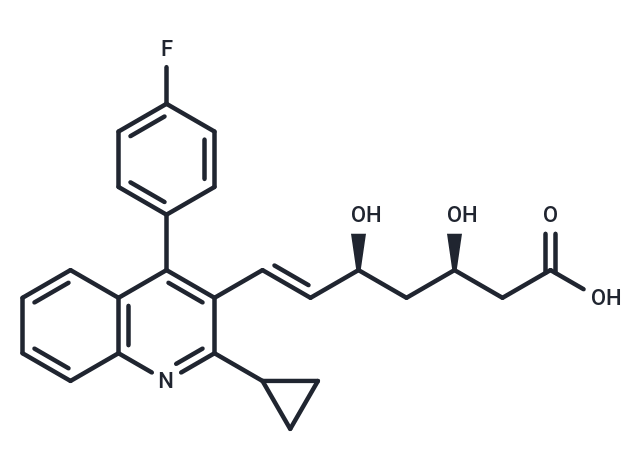Shopping Cart
Remove All Your shopping cart is currently empty
Your shopping cart is currently empty
Pitavastatin (NK-104) is a potent inhibitor of hydroxymethylglutaryl-CoA (HMG-CoA) reductase, effectively inhibiting cholesterol synthesis from acetic acid in HepG2 cells with an IC50 of 5.8 nM. It also induces hepatocyte low-density lipoprotein-cholesterol (LDL-C) receptors and exhibits therapeutic activities such as anti-atherosclerotic, anti-asthmatic, anti-osteoarthritis, antineoplastic, neuroprotective, hepatoprotective, and reno-protective effects.

| Pack Size | Price | USA Warehouse | Global Warehouse | Quantity |
|---|---|---|---|---|
| 5 mg | $33 | In Stock | - | |
| 10 mg | $45 | In Stock | - | |
| 25 mg | $64 | In Stock | - | |
| 50 mg | $92 | In Stock | - | |
| 100 mg | $133 | 1-2 weeks | 1-2 weeks | |
| 500 mg | $328 | 1-2 weeks | 1-2 weeks | |
| 1 mL x 10 mM (in DMSO) | $37 | In Stock | In Stock |
| Description | Pitavastatin (NK-104) is a potent inhibitor of hydroxymethylglutaryl-CoA (HMG-CoA) reductase, effectively inhibiting cholesterol synthesis from acetic acid in HepG2 cells with an IC50 of 5.8 nM. It also induces hepatocyte low-density lipoprotein-cholesterol (LDL-C) receptors and exhibits therapeutic activities such as anti-atherosclerotic, anti-asthmatic, anti-osteoarthritis, antineoplastic, neuroprotective, hepatoprotective, and reno-protective effects. |
| In vitro | Pitavastatin inhibits the growth of a panel of ovarian cancer cells, including those likely representing HGSOC, with IC50 values of 0.4-5 μM in monolayers and 0.6-4 μM in spheroids [4]. At 1 μM for 48 hours, Pitavastatin induces apoptosis in Ovcar-8 and Ovcar-3 cells, increasing the activity of caspases-3, -7, -8, and -9, and results in PARP cleavage in Ovcar-8 cells, as evidenced by Western Blot analysis [1, 4]. |
| In vivo | In 4-week-old female NCR Nu/Nu nude mice bearing Ovcar-4 tumors, Pitavastatin (administered at a dose of 59 mg/kg; orally (p.o.); twice daily for 28 days) is able to significantly induce tumor regression[4]. |
| Synonyms | NK-104, NK104, NK 104 |
| Molecular Weight | 421.46 |
| Formula | C25H24FNO4 |
| Cas No. | 147511-69-1 |
| Smiles | C(=C/[C@H](C[C@H](CC(O)=O)O)O)\C1=C(C2=C(N=C1C3CC3)C=CC=C2)C4=CC=C(F)C=C4 |
| Relative Density. | 1.352g/cm3 |
| Storage | store at low temperature | Powder: -20°C for 3 years | In solvent: -80°C for 1 year | Shipping with blue ice/Shipping at ambient temperature. | ||||||||||||||||||||||||||||||
| Solubility Information | DMSO: 33.13 mg/mL (78.61 mM), Sonication is recommended. | ||||||||||||||||||||||||||||||
| In Vivo Formulation | 10% DMSO+40% PEG300+5% Tween 80+45% Saline: 3.3 mg/mL (7.83 mM), Sonication is recommended. Please add the solvents sequentially, clarifying the solution as much as possible before adding the next one. Dissolve by heating and/or sonication if necessary. Working solution is recommended to be prepared and used immediately. The formulation provided above is for reference purposes only. In vivo formulations may vary and should be modified based on specific experimental conditions. | ||||||||||||||||||||||||||||||
Solution Preparation Table | |||||||||||||||||||||||||||||||
DMSO
| |||||||||||||||||||||||||||||||
| Size | Quantity | Unit Price | Amount | Operation |
|---|

Copyright © 2015-2026 TargetMol Chemicals Inc. All Rights Reserved.